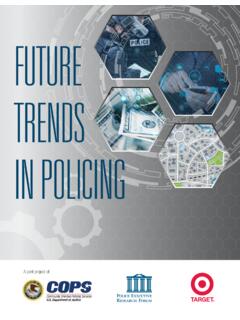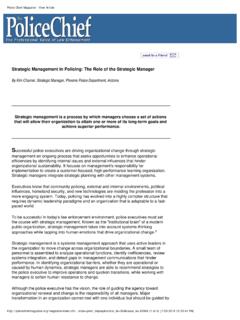Transcription of Effectiveness of Police in Reducing Crime and the Role of ...
1 40 CHAPTER 1 CHAPTER 3 Effectiveness of Police in Reducing Crime and the Role of Crime AnalysisChapter 2 presents the theoretical foundation for understanding how Crime and disorder occur; it also details ways to reduce opportunities and prevent problematic activity, based on theory. This chapter links these theoretical concepts with Crime reduction practice by Police . As dis-cussed in Chapter 1, the primary purpose of Crime analysis is to assist Police ; the focus of this chapter is on what works in policing for preventing and controlling Crime and the role of Crime analysis in assisting with these efforts. Importantly, research and practice have shown the most effective methods Police employ to prevent and control Crime are those in which Crime analysis plays a vital Effectiveness in Preventing and Controlling CrimeIn the last 30 years, American policing has seen significant changes in both thinking and practice (Weisburd & Braga, 2006a).
2 Technological advances, new perspectives on policing , and evaluations of current practices have brought about these changes. A number of Police scholars as well as the National Academy of Sciences Committee to Review Research on Police Policies and Practice have examined exist-ing research to determine what works for preventing and controlling Crime in policing (Sherman et al., 1997; Skogan & Frydl, 2004; Weisburd & Eck, 2004). The following is a brief overview of the key elements and research results for the most notable Police strategies the standard model of policing , commu-nity policing , broken windows policing , hot spots policing , Compstat, and problem-oriented Model of PolicingThe standard model of policing encompasses strategies that come to mind when the average per-son thinks about what Police are supposed to do. The central element of the standard model Effectiveness of Police in Reducing Crime and the Role of Crime Analysis 41involves enforcing the law in a broad and reactive way, primarily using Police resources (Weisburd & Eck, 2004).
3 Specifically, the strategies of the standard model of policing include the following (Sherman et al., 1997; Weisburd & Eck, 2004): Increased number of Police officers (to increase the ability to detect Crime and arrest offenders) Unfocused, random motorized patrols (to create a perception of a Police omnipresence to deter Crime in public places) Rapid response to calls for service (to increase the likelihood of catching offenders) Follow-up investigations by detectives (to increase the solvability of the crimes) General reactive arrest policies (to deter and punish specific offenders as well as deter the general public from committing crimes)There have been only a limited number of evaluations of these strategies; the available research shows that each one of these generally applied enforcement efforts has been of limited Effectiveness (Sherman et al., 1997; Skogan & Frydl, 2004; Weisburd & Eck, 2004).
4 Community PolicingPolice scholars have touted community policing as one of the most widely adopted Police strategies in the last several decades (Weisburd & Eck, 2004). However, it is difficult to define, because its definition has changed over time, and its concepts are vague. The key elements of community polic-ing are that Police must work with the community and draw from other resources outside the Police to prevent and solve Crime problems. According to the Department of Justice s Office of Community Oriented policing (2011a), community policing isA philosophy that promotes organizational strategies which support the systematic use of partnerships and problem-solving techniques, to proactively address the immediate con-ditions that give rise to public safety issues such as Crime , social disorder, and fear of Crime . (para. 1)Because community policing is difficult to define and has evolved from being considered a strategy to being considered a philosophy, overall it is difficult to evaluate.
5 However, specific strate-gies have been used primarily to represent community policing in evaluations. One strategy is neighborhood watch (also called block watch), which is one of the most implemented community policing programs; it has the goal of increasing surveillance by residents and community members of their own neighborhoods. Other strategies include increasing the flow of information from the community to the Police through community meetings, officers walking the beat and talking to residents, and storefront beat offices; and providing Crime information to the public through the Internet, Crime maps, letters, and reverse 911 phone calls so they can protect themselves (Sherman et al., 1997).The overall results of research evaluations of community policing show that neighborhood watch, community meetings, storefront offices, and newsletters do not reduce Crime (Weisburd & Eck, 2004).
6 While door-to-door visits by the Police have been found to reduce Crime , simply providing information about Crime to the public has not been shown to prevent Crime (Sherman et al., 1997; Weisburd & Eck, 2004). Consequently, overall community policing as measured by these specific strategies does not seem to increase Police Effectiveness at prevent-ing Crime ; however, it has been shown to reduce fear of Crime (Weisburd & Eck, 2004). 42 FOUNDATIONS OF Crime ANALYSISH owever, the philosophy that Police should engage the community and partner with them to deal with problems is one to which most Police departments in the United States Windows PolicingBroken windows policing (also called zero tolerance policing ) is based on practical theory devel-oped in the 1980s (Wilson & Kelling, 1982). It focuses on the strict enforcement of laws against disorderly behavior and minor offenses (considered quality of life offenses), such as prostitution, public urination, and aggressive panhandling (Sousa & Kelling, 2006).
7 The intent is to prevent more serious crimes from happening. The term broken windows is a metaphor that alludes to the fact that if a broken window is left unfixed, it indicates that no one cares and invites more broken win-dows and more serious criminal behavior (Sousa & Kelling, 2006).Research results of the Effectiveness of broken windows policing have been mixed. A summary of studies in seven cities (Skogan, 1990, 1992) found no evidence that the strict enforcement of disorder ordinances reduced additional disorder or more serious crimes. Another more recent study (Kelling & Sousa, 2001) found a direct link between misdemeanor arrests and a reduction in more serious Crime , but data limitations raised questions about the validity of the study s conclusions. New York City used this type of policing intensively in the 1990s, and many NYC officials have con-cluded it was the reason why the Crime rate dropped during that time.
8 However, researchers have not rigorously evaluated these claims, and many cite other reasons for New York City s Crime decrease ( , effect of the crack epidemic as well as general Crime and economic trends) (Weisburd & Eck, 2004).Hot Spots PolicingThe key idea behind hot spots policing is that a disproportionate number of crimes happens in particular areas in a city ( , 80/20 rule from Chapter 2). In fact, research shows this; for example, Sherman, Gartin, and Buerger (1989) found that 3% of addresses accounted for 50% of the Crime calls to the Police . Therefore, hot spots policing is the strategy in which Police systematically identify areas within a city that have disproportionate amounts of Crime and employ responses in those specific areas. Oftentimes, Police implement traditional responses in hot spots, such as increased Police presence and arrests (Weisburd & Braga, 2006b).
9 There has been a significant amount of rigorously applied research on hot spots policing , and the combined results indicate that it contributes to meaningful reductions of both Crime and disorder (Braga 2008; Braga & Bond, 2008; Ratcliffe, Taniguchi, Groff, & Wood, 2011; Weisburd & Eck, 2004). Police crackdowns more temporary applications of hot spots policing also have been shown to work, although primarily on a short-term basis (Scott, 2004; Weisburd & Eck, 2004). When determining the Effectiveness of hot spots policing , officials need to consider whether it actually prevents Crime or just moves it to a different area ( , displacement of Crime ). Numerous studies have examined this and, as noted in Chapter 2, have found that complete dis-placement rarely occurs, which means that even when a hot spot is moved, some Crime reduction has is the name of a specific program implemented by the New York City Police Department (NYPD) in 1994 (Silverman, 2006).
10 However, its rapid and widespread adoption by Police agencies around the United States has moved it beyond being an isolated strategy used by NYPD (Weisburd, Effectiveness of Police in Reducing Crime and the Role of Crime Analysis 43 Mastrofski, McNally, Greenspan, & Willis, 2003), and it has been described as perhaps the single most important organizational innovation in policing during the latter half of the 20th century (Silverman, 2006, p. 267).Compstat is important for two reasons: It takes the analysis of up-to-date computerized Crime , arrest, and quality of life data to produce statistics and maps; it uses this information in regular-ized, interactive Crime prevention and reduction strategy meetings where managers are held accountable for the Crime prevention approaches they implement in their districts. The Compstat model is an attempt to synthesize an accountability structure and strategic problem solving (Weisburd et al.)


















